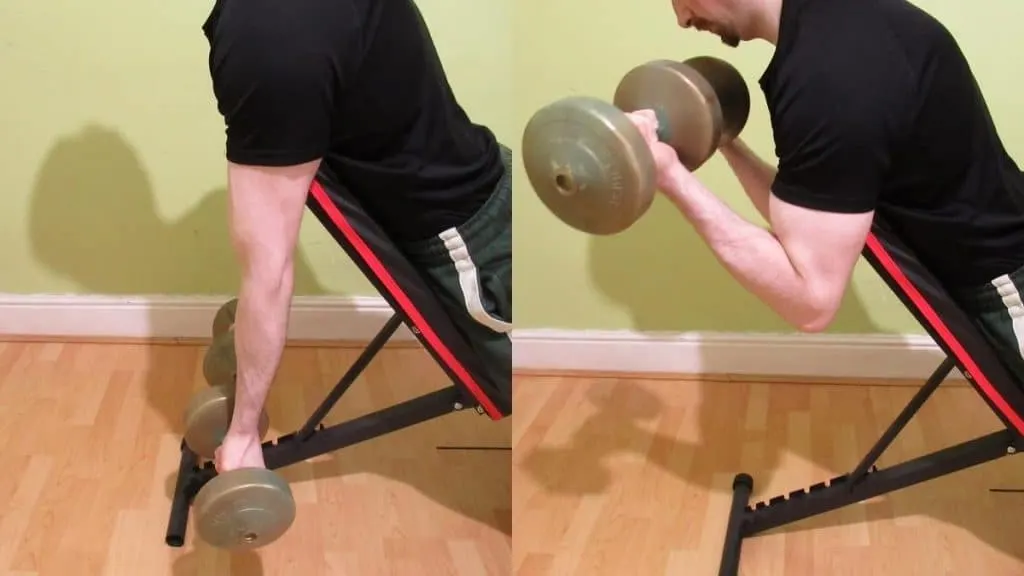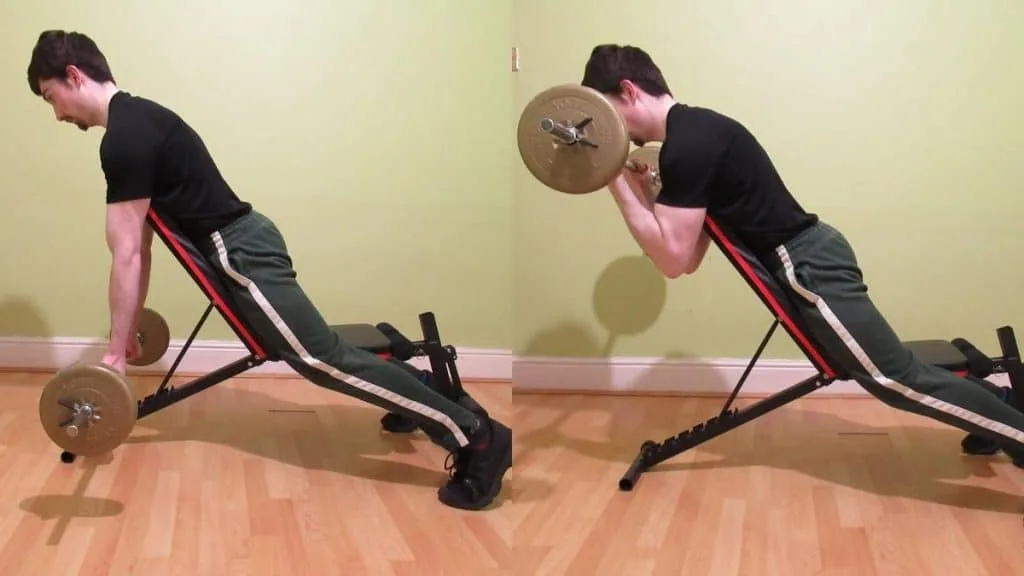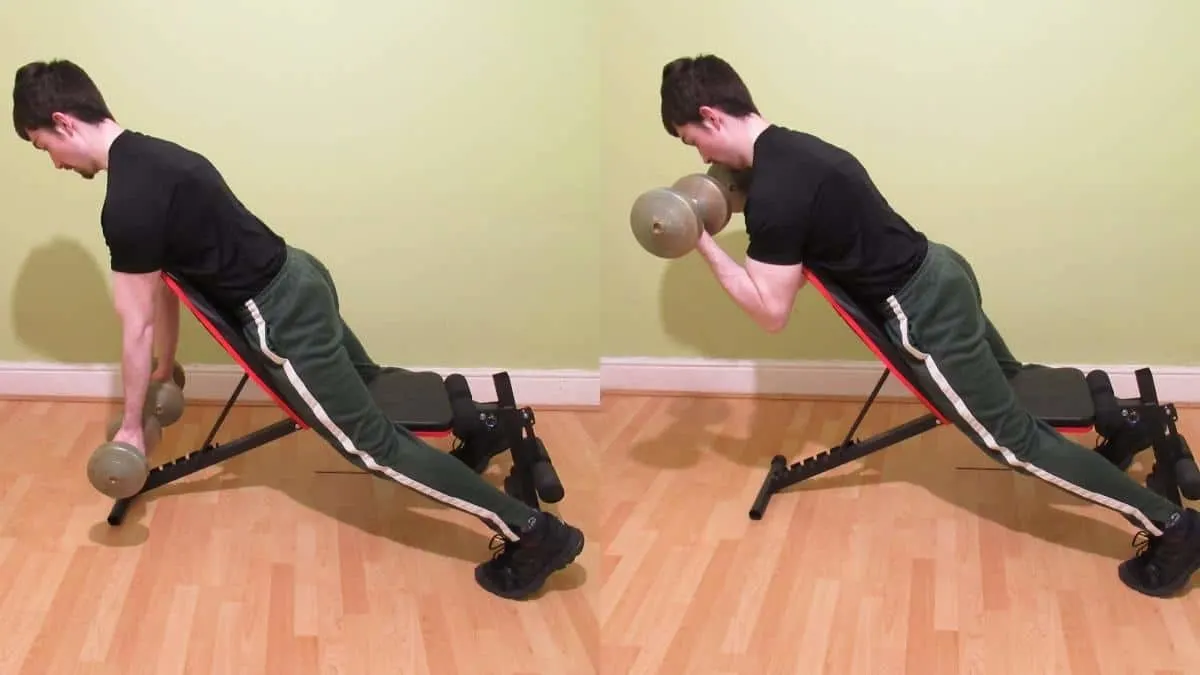The prone incline dumbbell curl is a useful exercise for isolating the bicep muscle. This is because by stabilizing your body against the bench, it’s much easier to keep the tension on your arms because you can’t cheat the weights up with your other muscles.
The prone curl is the opposite of the incline bicep curl. Not just in terms of body position, but also in terms of the muscles that they work. The prone incline curl emphasizes the short head of the biceps by having you curl the weight in front of your body. The regular version, on the other hand, primarily targets the long head of the biceps by having you curl with your arms behind your body.
Prone incline curl exercise details
- Main Muscles: Biceps brachii
- Secondary Muscles: Forearm flexors, brachioradialis, brachialis
- Exercise Type: Strength
- Exercise Mechanics: Isolation
- Difficulty Level: Beginner
- Equipment Needed: Adjustable bench, dumbbells
How to perform a prone incline dumbbell curl
- Set the backrest of an adjustable bench to a 60-degree angle.
- Place two dumbbells at the end of the bench.
- Sit on the bench in a reverse position with your torso pressed against the back pad.
- Reach down and grab the dumbbells with an underhand grip.
- Curl the weights toward your shoulders by moving your forearms toward your biceps.
- Flex your biceps forcefully at the top of the rep and then lower the weights under control until your elbows are completely locked out.
- Perform 3-5 sets of 8-15 reps in total.
Is the prone incline dumbbell curl good for building muscle?

The dumbbell prone incline curl is an excellent muscle-building exercise because it completely isolates your biceps. As with seated incline hammer curls, you can’t use your back, legs, or hips to generate momentum and cheat the weights up because your body is braced against the bench. This means that your biceps receive more tension and a stronger muscle growth stimulus.
Prone curls are not only effective for building large muscles, they’re great for developing symmetrical biceps as well.
Since you have to lift each weight independently, you can ensure that both of your arms are receiving equal work and are thus growing at the same rate. This, in turn, helps your overall physique to look more proportional because you’ll naturally have fewer muscle imbalances when you perform unilateral exercises like prone incline curls.
The main thing to remember is to keep your elbows still while you perform the movement. You don’t want to drag your elbows back, but you also don’t want them to come forward too much either.
Otherwise, you’ll shift the tension onto other body parts such as your shoulders.
Prone incline curl variations
There are three main types of prone bicep curl, including the dumbbell version that you saw above. Each version has its own pros and cons, so be sure to read this section to learn which variation is best for you and your physique goals.
Incline barbell curl

Incline barbell curls enable you to lift heavier weights than their dumbbell counterpart. This means that you’re able to overload your biceps with more resistance and potentially also stimulate faster rates of hypertrophy when you make barbells your primary training tool.
Why just potentially?
All else being equal, lifting heavier weights will result in more muscle growth. However, muscle tissue responds to tension, not weight. After all, your muscles don’t understand what free weights are.
Therefore, if you can put more force and torque through your biceps by using dumbbells—even if that means lifting lighter—then you may well stimulate faster rates of muscle growth by sticking with the dumbbell version of the prone curl.
As for gaining strength, the incline barbell curl is superior to the dumbbell version because you can increase the resistance of a barbell in more manageable increments. With dumbbells, on the other hand, the minimum weight jump is often 5lbs per side, which can actually be quite challenging for a muscle group as small as the biceps.
Modified prone curl

The modified prone curl is almost the same as the regular version. The only difference is that instead of curling the dumbbells straight up and down, you’re going to be curling them inward instead.
This entails internally rotating your shoulders so that your elbows are flared out to the sides. From there, you simply curl the weights toward your front delts and flex your biceps.
In terms of muscle activation, the modified variation places more emphasis on the long head of the biceps, whereas the standard version prioritizes the development of the short head.
You can also try the incline cable bicep curl if you want an exercise that provides constant muscle tension. The only drawback is that not everyone has access to cables these days, especially if they train at home.
Conclusion: Should you do the prone curl for your biceps?

If you’re seeking to maximally isolate your biceps, then the prone incline dumbbell curl is a great exercise to perform. Since your body is braced against the bench, your biceps have to handle the majority of the tension because you can’t use your other muscles (besides your front delts) to swing the weights up.
You can also do incline barbell curls if you want to gain strength on a more consistent basis. The reason being is that, as mentioned, you can easily microload barbells in much smaller weight increments than dumbbells.
References
- Robson, D. (2020, January 7). Symmetry: Why It Is Important and How To Achieve It! Bodybuilding.Com. https://www.bodybuilding.com/content/symmetry-why-it-is-important-and-how-to-achieve-it.html
- Erskine, R. M., Jones, D. A., Williams, A. G., Stewart, C. E., & Degens, H. (2010). Inter-individual variability in the adaptation of human muscle specific tension to progressive resistance training. European Journal of Applied Physiology, 110(6), 1117–1125. https://doi.org/10.1007/s00421-010-1601-9

